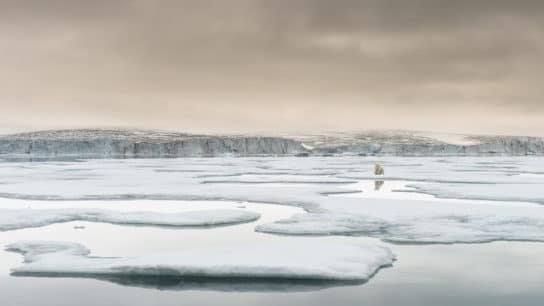There are endless examples of women-led sustainability movements and practices, as women, like our ecosystems, have been exploited, subjugated, and left to suffer the life-threatening impacts of the climate crisis at statistically higher rates.
—
Women, especially those of marginalized communities, are disproportionately affected by the consequences of environmental destruction. Still, they remain at the forefront of ecological restoration efforts as stewards of change.
As we survive in the Anthropocene – an epoch defined by humans’ effect on the geologic record – it is difficult to ignore how the exploitation of ecosystems is deeply entwined with the subjugation of women. Climate collapse, mass extinction, and shallow ecological politics have rendered future ecosystems in tremendous danger, yet the climate emergency’s impacts are not felt equally.
The United Nations estimates that 4 out of 5 people displaced by climate disasters are women and girls, with women and children estimated to be 14 times more likely to die than men due to disparities in the distribution of information and resources. These risks come not just from instances of extreme weather events but also long-term conditions that stem from climate and environmental changes, which – the National Institute of Health notes – can “negatively impact many stages of a woman’s reproductive life.” As these changes worsen pre-existing inequalities, marginalized women often face greater threats from resource insecurity and extreme weather, placing their safety and health at a statistically higher risk than men’s.
And yet, women carry the torch for environmental justice across the globe. What follows are just a few examples, among countless others, of the stewardship that has been and is being done.
The Navdanya Movement
Navdanya, an Indian non-profit co-founded by world-renowned scientist and ecofeminist scholar Dr. Vandana Shiva in 1984, defines itself as, “an Earth Centric, Women centric and Farmer led movement for the protection of Biological and cultural Diversity.” The name means “nine seeds,” representing India’s collective source of food security, “a gift of life, of heritage and continuity.”
Dr. Shiva has done revolutionary work in the field of ecofeminist scholarship, declaring that “The paradigm of capitalist patriarchy declared nature as dead and women as the second sex. But nature is alive, and nature and women are intelligent, creative, (and) productive.”

The women-centric, farmer-led movement works through seed saving practices, organic farming, and farmer’s rights activism to protect India’s biodiversity-based food heritage amidst the, “erosion of agriculture biodiversity and introduction of GMOs and patents on seeds through Intellectual Property Rights.”
The Chipko Movement

Rural women in the Himalayan region of India led to the rise of the Chipko movement, meaning “to hug” or “to cling to”, in the 1970s. This grassroots “tree-hugging” movement, as noted by Aysha Sadak, “birthed the first ecofeminist movement of its kind,” as protestors refused to abandon 2,000 trees scheduled to be felled – forcing out loggers and bringing forth a 10-year ban on logging in the area. The protests worked towards affirming local people’s rights over their indigenous lands, resources, and livelihoods.
More on the topic: 50 Years On: The Legacy of India’s Chipko Movement
Women Leaders of Standing Rock
When Indigenous activists and allies protested the Dakota Access Pipeline in 2016, Indigenous women played an integral role in the organization and transmission of traditional ecological knowledge at Standing Rock. Serving as spiritual leaders, Indigenous women led prayer circles, passed down oral histories, and acted as the backbone of the water protectors.

As noted by Shannon Kring for Time Magazine, “The women of Standing Rock are willing to risk their lives to stop the pipeline construction that desecrated their ancient burial and prayer sites and threatens their land, water, and very existence.” The leadership and activism of the women at Standing Rock was an unwavering act of love, resilience, and duty towards their communities and land.
The Green Belt Movement
Professor Wangari Maathai’s Green Belt Movement in Kenya has planted over 51 million trees and created opportunities for 30,000 Kenyan women since 1977.

The movement seeked to empower women through environmental conservation work, from tree planting to gender livelihood advocacy. Its founder and awardee of the Nobel Peace Prize in 2004, Wangari Maathai, began the project “under the auspices of the National Council of Women of Kenya to respond to the needs of rural Kenyan women.”
Reports of insecure food supplies and drying streams were met with community action, as women organized to restore their environment and the security of their livelihoods. The movement directly addresses the land degradation and climate challenges faced by Kenyan women through tree planting and rewilding efforts that have inspired similar movements across the globe.
—
There are endless examples of women-led sustainability movements and practices, as women, like our ecosystems, have been exploited, subjugated, and left to suffer the life-threatening impacts of the climate crisis at statistically higher rates.
Women are the protagonists of our collective efforts in the fight for climate and ecological justice. We do not need to look to a future where women guide environmental policy, practice, and community resilience because it is already here. It has been here, as women have served as stewards of resource acquisition and community welfare across cultures and history. This longstanding reality places women’s leadership not just as essential in the future of ecological justice but as deeply embedded in the history and practice of climate justice.
Featured image: Wikimedia Commons.
More on the topic: Listening to Those Most Impacted by Climate Change
This story is funded by readers like you
Our non-profit newsroom provides climate coverage free of charge and advertising. Your one-off or monthly donations play a crucial role in supporting our operations, expanding our reach, and maintaining our editorial independence.
About EO | Mission Statement | Impact & Reach | Write for us















